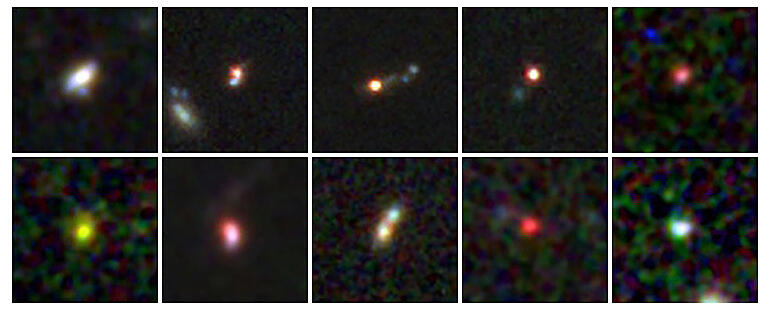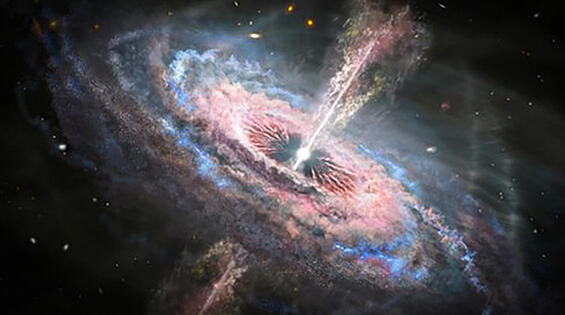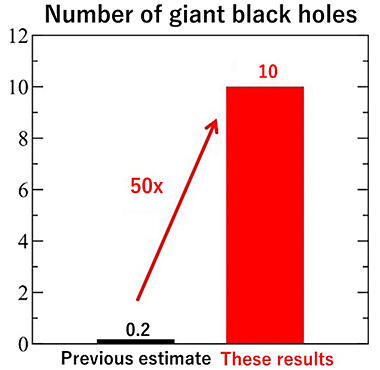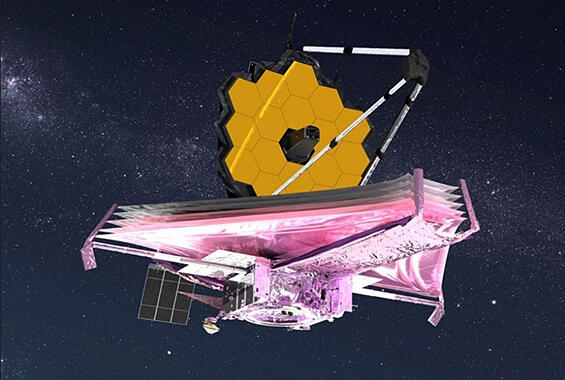A research group from the University of Tokyo and the National Astronomical Observatory of Japan (NAOJ) announced that the number of giant black holes at the center of galaxies in the early universe were 50 times greater than previously thought. The research group unexpectedly discovered 10 giant black holes from data in a narrow field of view approximately 12− 13 billion light-years away, using the James Webb Space Telescope, which began observations last year. The observations revealed that, at that time, giant black holes were present in a variety of galaxy types and were expanding at a rapid rate. This is a significant achievement in the investigation into the mechanism underlying the birth of giant black holes.

Provided by NASA, ESA, the Canadian Space Agency and Assistant Professor Yuichi Harikane et al.
A black hole is an extremely dense celestial body with extremely strong gravity. According to the general theory of relativity, the surrounding space-time is distorted, and even light cannot escape. They are formed when a heavy star contracts after a supernova at the end of its life. Furthermore, giant black holes that are one million to one billion times heavier than the sun are present at the centers of several galaxies. However, the detailed timing and mechanism of their births are not well understood. The Milky Way Galaxy (our galaxy) also has a giant black hole, Sagittarius A Star, at its center.
Light takes time to reach us. For instance, when we observe celestial bodies that are 10 billion light-years away with a telescope, we are effectively perceiving them as they appeared 10 billion years ago. Similarly, examining a galaxy or black hole at a distance provides insights into past conditions.
However, distant black holes are difficult to observe. Giant black holes located approximately 12−13 billion light-years away (meaning from approximately 12−13 billion years ago), have traditionally been discovered using ground-based telescopes. This method has been used to capture the brilliance of celestial objects called "quasars," which are giant black holes swallowing surrounding matter. Because this method found only 1/1000th of the number of galaxies of the same age, giant black holes have been thought to be very rare in the early universe.

Provided by NASA, ESA and J. Olmsted at the U.S. Space Telescope Science Institute
The James Webb Space Telescope, operated by the United States, Europe and Canada, has considerably improved the sensitivity of infrared observations of the distant universe. In this study, the research group examined this telescope's observation data and found distinctive hydrogen signatures indicating the existence of giant black holes in 10 of the 185 galaxies that existed approximately 12−13 billion years ago. Based on previous findings, it was expected that theoretically, 0.2 galaxies (basically none at all) would be found in the narrow field of view of the same telescope. However, unexpectedly, 50 times the expected number was discovered.
This telescope also captured the light of a galaxy with a giant black hole at its center. This light was yellow, blue-white and red, and had a variety of shapes. It tells us that giant black holes existed universally in various types of galaxies at that time.
The mass of the giant black hole captured this time is only 1/100th of the mass of the giant black hole at the center of a quasar that has been observed previously and is believed to be closer to the early stage of formation. It is possible that the giant black hole was rapidly growing during this period.
Assistant Professor Yuichi Harikane, who conducts research on astrophysics at the Institute for Cosmic Ray Research at the University of Tokyo said at a press conference, "The formation and growth of giant black holes in the early universe occurred more rapidly than previously thought. This discovery represents a significantly impactful achievement towards understanding their origins. While theoretical models have been proposed to explain the scarcity of quasars, this new finding remains unexplained. Moreover, considering types other than those captured in this study, the number of giant black holes might have been even greater. Further investigations, including a detailed examination of periods earlier than 13 billion years ago, are desired to continue approaching a comprehensive understanding."
The results were published in Astrophysical Journal, a U.S. astronomy journal, on December 6, 2023.

Provided by Assistant Professor Harikane et al. and translated by Science Japan
Following this achievement, the research group, including Harikane and colleagues at the University of Tokyo and NAOJ, announced that, based on data from the James Webb Space Telescope, five galaxies at distances of 13.4−13.5 billion light-years (which is the most distant ever observed) have been found to be forming stars one after another in a shorter time than previous theories predict. Two of the five galaxies are newly discovered. The research group stated, "This finding suggests the possibility of a formation process for galaxies in the early universe that differs from what has been previously thought, providing important clues to understanding the nature of the first galaxies." These results were also published in Astrophysical Journal on December 23.

Provided by NASA
Original article was provided by the Science Portal and has been translated by Science Japan.




